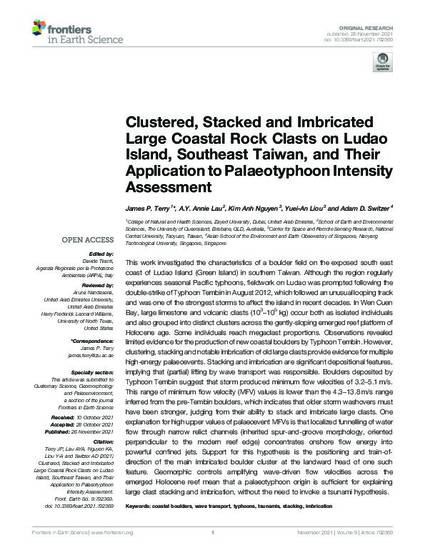
This work investigated the characteristics of a boulder field on the exposed south east coast of Ludao Island (Green Island) in southern Taiwan. Although the region regularly experiences seasonal Pacific typhoons, fieldwork on Ludao was prompted following the double-strike of Typhoon Tembin in August 2012, which followed an unusual looping track and was one of the strongest storms to affect the island in recent decades. In Wen Cuen Bay, large limestone and volcanic clasts (103–105 kg) occur both as isolated individuals and also grouped into distinct clusters across the gently-sloping emerged reef platform of Holocene age. Some individuals reach megaclast proportions. Observations revealed limited evidence for the production of new coastal boulders by Typhoon Tembin. However, clustering, stacking and notable imbrication of old large clasts provide evidence for multiple high-energy palaeoevents. Stacking and imbrication are significant depositional features, implying that (partial) lifting by wave transport was responsible. Boulders deposited by Typhoon Tembin suggest that storm produced minimum flow velocities of 3.2–5.1 m/s. This range of minimum flow velocity (MFV) values is lower than the 4.3–13.8 m/s range inferred from the pre-Tembin boulders, which indicates that older storm washovers must have been stronger, judging from their ability to stack and imbricate large clasts. One explanation for high upper values of palaeoevent MFVs is that localized funnelling of water flow through narrow relict channels (inherited spur-and-groove morphology, oriented perpendicular to the modern reef edge) concentrates onshore flow energy into powerful confined jets. Support for this hypothesis is the positioning and train-of-direction of the main imbricated boulder cluster at the landward head of one such feature. Geomorphic controls amplifying wave-driven flow velocities across the emerged Holocene reef mean that a palaeotyphoon origin is sufficient for explaining large clast stacking and imbrication, without the need to invoke a tsunami hypothesis.
Available at: http://works.bepress.com/james-terry/29/
